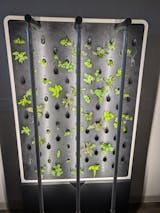Author: Dennis Lee
Part of the allure of growing your own food is exercising greater control over what you eat. The assumption is that this is generally ‘better’ for you. At Just Vertical, we want to know if growing food hydroponically at home really improves nutritional habits. How to measure this objectively, however, is a monumental task.
To understand how our products like the AEVA and EVE can improve nutritional levels in food we consume, we ask ourselves three questions.
1. What makes something nutritious or healthy in a quantifiable way?
For simplicity, we can think of food as measurable macronutrients and micronutrients (which is usually measured by weight).
Macronutrients include carbohydrates, fats, and protein. These are usually dependent on the types of food you eat. For example, pasta can be a rich source of carbohydrates while avocados and nuts are rich sources of fats.
Alternatively, micronutrients include organic vitamins and inorganic minerals. These are necessary for normal physiological function.
A nutritious diet includes diverse foods made up of a good balance of various macronutrients and is rich in micronutrients, as reflected by various food guides (such as Canada’s food guide found here).
2. How do we quantify nutrients?
Specific tools such as mass spectrometry, high performance liquid chromatography (analytical equipment typically found in chemistry and food testing labs), and others can be used to identify the exact compounds and physical properties of food.
Just like in your favourite crime show (but with much longer wait times and less accuracy), these machines help scientists breakdown which minerals, compounds and organics (such as vitamins) are found in a given sample.
From there, we can estimate the overall abundance of a given nutrient.
3. How do nutrient levels compare when you add in the impact of external variables?
The composition of your food can be drastically altered by factors including growing practices, shipping, seasonality, and many others. For example, elevated levels of ambient CO2 (as expected from climate change) leads to decreased micronutrient levels in a wide variety of rice grains. We should therefore test produce side-by-side, as we can only be confident in comparisons when we test them against each other.
When you grow your own food, that food has never been tested for it’s nutritional levels. What you might be eating may have drastically different nutrient levels than what you can find in easily accessible literature (ie. on google).
Compared to growing outside, the AEVA (or the EVE) is a standardized indoor growing setup that can lead to reproducible results. This means we can readily compare what we grow in Just Vertical units and that can be used as a good estimate for what you may achieve in your own units.
We’ve recently entered into a unique partnership with Seneca College to measure various inorganic and organic micro and macronutrients in produce grown in our hydroponic units, and compared that to produce from a variety of external sources, such as in supermarkets.
We’ll be releasing key findings from those studies in upcoming blog posts, exploring how we’ve applied our methodology mentioned above for real-life implications.

